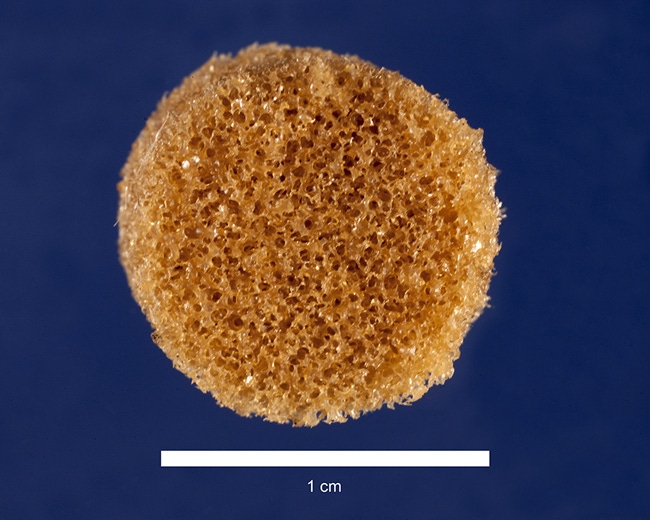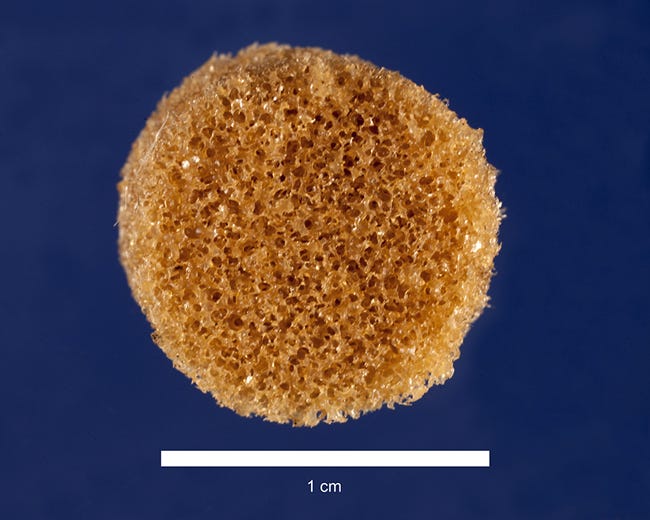Sponge-like polymer could repair bone defects
A sponge-like polymer, polycaprolactone (PCL) shows promise as a medical material that can be used to fill gaps in human bone and serve as a scaffold to promote new bone growth. Injuries, birth defects (such as cleft palates), or the removal of tumors can create gaps in bone that are too large to heal naturally. The gaps can dramatically alter a person's appearance when they occur in the head, face, or jaw. The polymer has the potential to improve upon the two most commonly used procedures to repair these bone gaps.
August 14, 2014

A sponge-like polymer, polycaprolactone (PCL) shows promise as a medical material that can be used to fill gaps in human bone and serve as a scaffold to promote new bone growth. Injuries, birth defects (such as cleft palates), or the removal of tumors can create gaps in bone that are too large to heal naturally. The gaps can dramatically alter a person's appearance when they occur in the head, face, or jaw. The polymer has the potential to improve upon the two most commonly used procedures to repair these bone gaps. Melissa Grunlan, PhD, who led the study on the "self-fitting material" at Texas A&M University, presented the research at the 248th National Meeting & Exposition of the American Chemical Society (ACS) in San Francisco, CA, this week.
Two approaches are currently used to fill cranio-maxillofacial bone defects, both of which have drawbacks. The most common method is autografting, where surgeons harvest bone from somewhere else on the body and try to shape it to fit the bone defect.
"The problem is that the autograft is a rigid material that is very difficult to shape into these irregular defects," Grunlan said in a statement. Also, harvesting bone for the autograft can create complications in the part of the body where the bone was taken.
The second approach is to use bone putty or cement to plug gaps. However, these materials become brittle as they harden and they lack pores that would allow new bone cells to move in and rebuild the damaged tissue.
Grunlan and her colleagues at Texas A&M University advocate a third way that involves the use of a nonbrittle shape-memory polymer (SMP) that molds itself precisely to the shape of the bone defect and supports the growth of new bone tissue.
 The porous SMP foam is made by linking together molecules of poly(ε-caprolactone), an elastic, biodegradable substance that is already used in some medical implants. The resulting material resembles a stiff sponge, with many interconnected pores that bone cells can migrate to and grow.
The porous SMP foam is made by linking together molecules of poly(ε-caprolactone), an elastic, biodegradable substance that is already used in some medical implants. The resulting material resembles a stiff sponge, with many interconnected pores that bone cells can migrate to and grow.
When heated to 140°F, the SMP becomes soft and malleable. During surgery to repair a bone defect, for example, a surgeon would warm the SMP to that temperature and fill in the defect with the softened material. As the SMP cools to the body temperature, it resumes its former stiff texture and settles into place.
The researchers also coated the SMPs with polydopamine, a sticky substance that helps lock the polymer into place by inducing formation of a mineral that is found in bone. It may also help osteoblasts, the cells that produce bone, to adhere and spread throughout the polymer. The SMP is biodegradable: the scaffold eventually disappears, leaving only new bone tissue behind.
To test whether the SMP scaffold could support bone cell growth, the researchers seeded the polymer with human osteoblasts. After three days, the polydopamine-coated SMPs had grown about five times more osteoblasts than those without a coating. Furthermore, the osteoblasts produced more of the two proteins, runX2 and osteopontin, that are critical for new bone formation.
Grunlan says that the next step will be to test the SMP's ability to heal cranio-maxillofacial bone defects in animals. "The work we've done in vitro is very encouraging," she said. "Now we'd like to move this into preclinical and, hopefully, clinical studies."
About the Author(s)
You May Also Like


